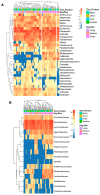Effects of cRG-I Prebiotic Treatment on Gut Microbiota Composition and Metabolic Activity in Dogs In Vitro
- PMID: 40871329
- PMCID: PMC12388317
- DOI: 10.3390/microorganisms13081825
Effects of cRG-I Prebiotic Treatment on Gut Microbiota Composition and Metabolic Activity in Dogs In Vitro
Abstract
Low-dose carrot rhamnogalacturonan-I (cRG-I) has shown consistent modulatory effects on the gut microbiota and immune function in humans. In this study we investigated its effects on the microbial composition and metabolite production of the gut microbiota of small (5-10 kg), medium-sized (10-27 kg), and large (27-45 kg) dogs, using inulin and xanthan as comparators. Fecal samples from six dogs of each size group were evaluated. Overall microbiome composition, assessed using metagenomic sequencing, was shown to be driven mostly by dog size and not treatment. There was a clear segregation in the metabolic profile of the gut microbiota of small dogs versus medium-sized and large dogs. The fermentation of cRG-I specifically increased the levels of acetate/propionate-producing Phocaeicola vulgatus. cRG-I and inulin were fermented by all donors, while xanthan fermentation was donor-dependent. cRG-I and inulin increased acetate and propionate levels. The responses of the gut microbiota of different sized dogs to cRG-I were generally consistent across donors, and interindividual differences were reduced. This, together with the significant increase in P. vulgatus during fermentation in both this study and an earlier human ex vivo study, suggests that this abundant and prevalent commensal species has a core capacity to selectively utilize cRG-I.
Keywords: cRG-I; canine gut microbiome; carrot rhamnogalacturonan-I; dietary fiber; metagenomics; prebiotic.
Conflict of interest statement
Author Sue McKay was employed by the company NutriLeads BV, authors Helen Churchill, Matthew R. Hayward, and Brian A. Klein were employed by the company dsm-firmenich, authors Lieven Van Meulebroek, Jonas Ghyselinck, and Massimo Marzorati were employed by the company ProDigest BV.
Figures







References
-
- Hoy M.K., Goldman J.D. Fiber Intake of the U.S. Population. What We Eat in America, NHANES 2009–2010. [(accessed on 7 April 2025)]; Available online: https://www.ars.usda.gov/arsuserfiles/80400530/pdf/dbrief/12_fiber_intak....
-
- Centers for Disease Control and Prevention. National Center for Health Statistics NHANES Report. What We Eat in America, NHANES 2009–2010. Table 1. [(accessed on 7 April 2025)]; Available online: https://www.ars.usda.gov/ARSUserFiles/80400530/pdf/0910/tables_1-40_2009....
LinkOut - more resources
Full Text Sources

